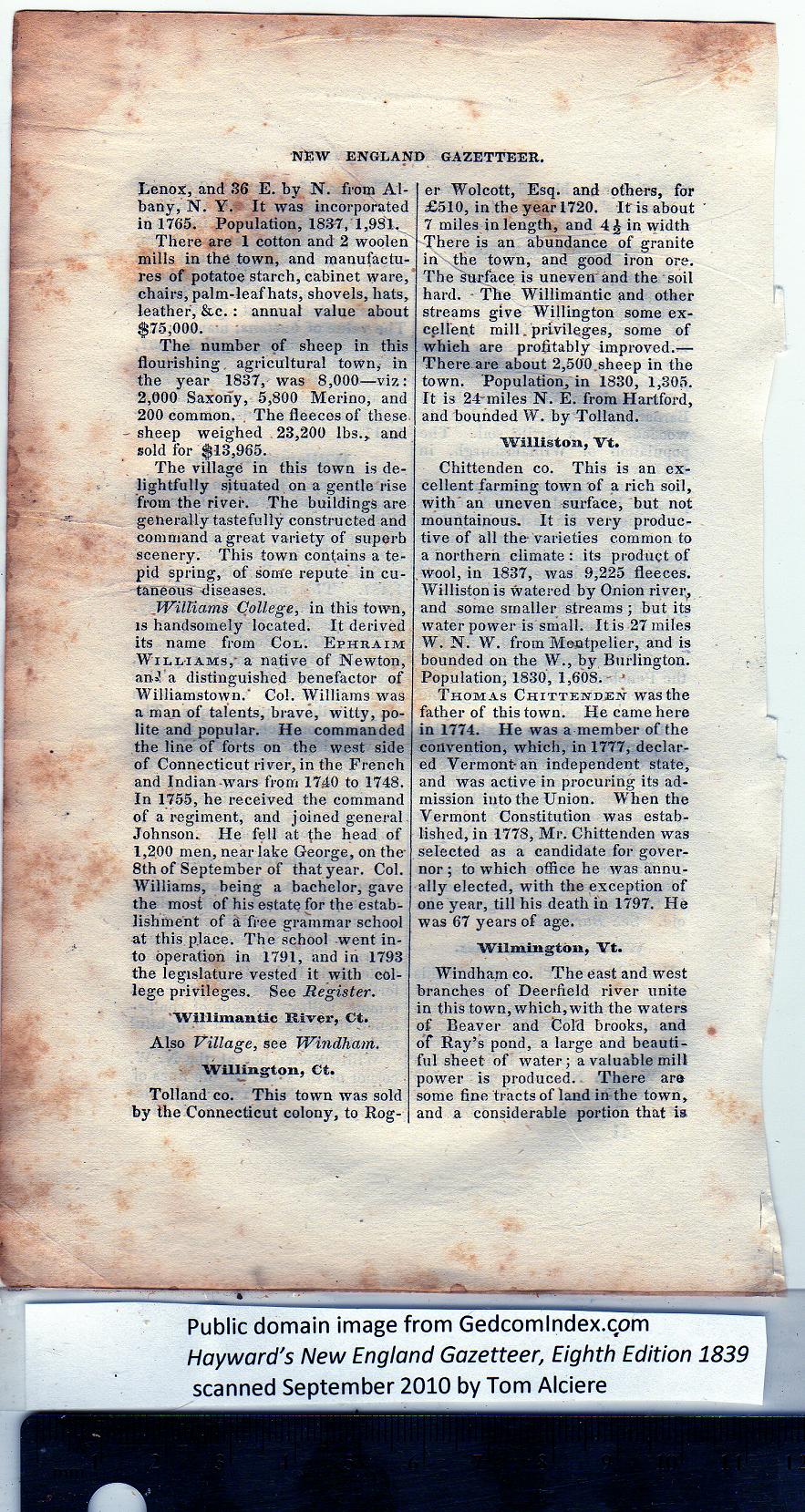|
Lenox, and 36 E. by N. from Al-
bany, N. Y. It was incorporated
in 1765. Population, 183-7/1,951.
There are 1 cotton and 2 woolen
mills in the town, and manufactu-
res of potatoe starch, cabinet ware,
chairs, palm-leaf hats, shovels, bats,
leather, &c.: annual value about
$75,000.
The number of sheep in this
flourishing, agricultural town, in
the year 1837, was 8,000—viz:
2,000 Saxony, 5,800 Merino, and
200 common. , The fleeces of these
sheep weighed .23,200 lbs., and
sold for $13,965.
The village in this town is de-
lightfully situated on a gentle rise
from the river. The buildings are
generally tastefully constructed and
command a great variety of superb
scenery. This town contains a te-
pid spring, of some repute in cu-
taneous diseases.
Williams College, in this town,
is handsomely located. It derived
its name from Col. Ephraim
Williams, a native of Newton,
arU a distinguished benefactor of
Williamstown.' Col. Williams was
a man of talents, brave, witty, po-
lite and popular. He commanded
the line of forts on the west side
of Connecticut river, in the French
and Indian-wars from 1740 to 1748.
In 1755, he received the command
of a regiment, and joined general
Johnson. He fell at the head of
1,200 men, near lake George, on the-
8th of September of that year. Col.
Williams, being a bachelor, gave
the most of his estate for the estab-
lishment of a free grammar school
at this place. The school went in-
to operation in 1791, and in 1793
the legislature vested it with col-
lege privileges. See Register.
"Willimantic River, Ct.
Also Village, see Windham.
Willington, Ct. |
Tolland co. This town was sold
by the Connecticut colony, to Rog-
er Wolcott, Esq. and others, for
£510, in the year 1720. It' is about
7 miles in length, and 4^ in width
There is an abundance of granite
in the town, and good iron ore.
The'surface is uneven'and the soil
hard. - The Willimantic and other
streams give Willington some ex-
cellent mill.privileges, some of
which are profitably improved.—
There are about 2,500,sheep in the
town. 'Population, in 1830, 1,305.
It is 24-miles N. E. from Hartford,
and bounded W. by -Tolland.
Williston, Vt.
Chittenden co. This is an ex-
cellent farming town of a rich soil,
with' an uneven surface, but not
mountainous. It is very produc-
tive of all the- varieties common to
a northern climate: its product of
wool, in 1837, was 9,225 fleeces.
Williston is watered by Onion river,
and some smaller streams; but its
waterpower is small. It is 27 miles
W. N. W. from Montpelier, and is
bounded on the W., by Burlington.
Population, 1830, 1,608.
Thomas Chittenden was the
father of this town. He came here
in 1774. He was a member of the
convention, which, in 1777, declar-
ed Vermont-an independent state,
and was active in procuring its ad-
mission into the Union. When the
Vermont Constitution was estab-
lished, in 1778, Mr. Chittenden was
selected as a candidate for gover-
nor ; to which office he was annu-
ally elected, with the exception of
one year, till his death in 1797. He
was 67 years of age.
Wilmington, Vt.
Windham co. The east and west
branches of Deerfield river unite
in this town, which, with the waters
of Beaver and Cold brooks, and
of Ray’s pond, a large and beauti-
ful sheet of water; a valuable mill
power is produced. There are
some fine tracts of land in the town,
and a considerable portion that is. |
